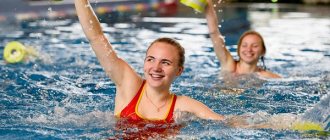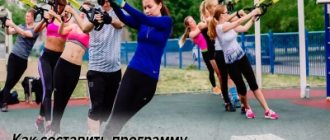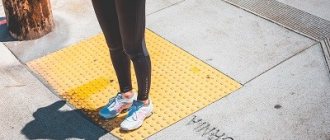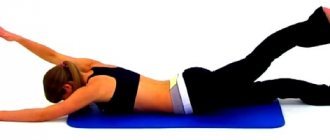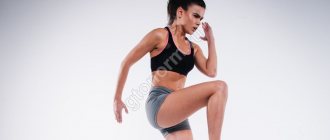Thigh toner
Lie forward and cross your ankles. Keeping your knees straight, lift both legs a short distance off the ground and hold them there for a minute. Now cross your legs in the other direction and repeat. Note: Avoid this exercise if you suffer from back pain.
Doing this simple exercise regularly will keep your buttocks toned. Sit with your legs straight in front of you and move forward on your buttocks as quickly as you can. Keep your arms extended straight out in front of you.
This simple exercise will help maintain the elasticity of the spine. Stand with your feet apart, arms outstretched, and rotate your waist as far as possible. Now turn in the other direction and increase the range of rotation. Let your arms swing with gravity.
Why are fitness classes necessary for the elderly?
First of all, you need to clearly understand why older people need fitness classes. Let’s not get away with general phrases about “health promotion” and “well-being,” but let’s look point by point at how regular physical exercise affects representatives of the older age group.
- Perhaps the most important purpose of fitness for the elderly is to strengthen muscles. After forty, a person begins a gradual decrease in the volume and strength of muscles, including those responsible for moving, holding the body in a standing or sitting position, and moving objects (the so-called skeletal muscles). This entails increased stress on bones and joints, incorrect posture, and degradation of bone tissue. Next in the chain are pinched nerves, excessive pressure on internal organs, and an increased risk of injury. Fitness for the elderly counters these processes. Although it does not prevent in principle, it slows down the rate of loss of muscle mass and strength as much as possible, and in some cases helps to partially restore them. It allows a person even at a very old age to retain the ability to move independently and self-service.
- In parallel with this, the elasticity of the ligamentous apparatus increases.
- Metabolic processes are accelerated. By receiving regular physical activity, the body activates its metabolism. This promotes better tissue regeneration, which is critical for older people, and also allows you to maintain normal body weight, preventing both obesity and exhaustion. The functioning of the digestive system also becomes more stable.
- The respiratory and cardiovascular systems are trained. This, on the one hand, supports the overall endurance of the body, and on the other, is an excellent prevention of heart attacks, hypertension, arrhythmia and other diseases.
- Regular exercise tones the body, which in turn stabilizes hormonal levels, which after about 45 years undergo serious changes. One of the consequences of this is a slowdown in the processes leading to osteopenia and osteoporosis (destruction of bone tissue).
- Physical activity improves coordination due to the regular functioning of the neuromuscular system.
- The immune system retains its functions, the defenses of which, as a rule, weaken with age.
- Pain syndrome decreases.
- By staying in good physical shape, a person perceives his age much easier, so training maintains a good psycho-emotional state, protects against depression and simply lifts your spirits. As a result, clarity of mind and good memory are maintained until old age. Another pleasant bonus is protection against insomnia.
By the way, you will achieve the maximum effect from your training if you combine fitness classes with taking specialized vitamin and mineral complexes or sports nutrition.
Fitness exercises for the elderly
Most older people should not focus on strength training. One of the main tasks for them is to stretch and work out their muscles, joints, and tendons. The muscles of an elderly person will receive sufficient load for it. Therefore, do not be confused by the fact that some of the exercises on the list look like warm-up exercises - in fact, their implementation requires quite adequate energy expenditure and brings tangible benefits.
- Head tilts. The exercise is performed standing, feet shoulder-width apart. At the initial stages, it is recommended to limit yourself to bending left and right, and add forward and backward movements after a few workouts.
- Head rotation. Be careful - you may lose your balance while doing this, so it is better to hold on to some kind of support. You can also enter head turns left and right into the program.
- Rotation of the arms at the shoulder joint. Place your hands on your shoulders, this will make it easier to control your movements.
- Rotation of the arms at the elbow joint. Place your arms in front of you, slightly apart, and rotate your forearms, first inward, then outward.
- "Swimming". Extend one arm forward and move it behind your back in a rotational motion, then repeat the action with the other arm. Perform several rotations continuously as if you were floating on your back. It is acceptable to perform at a fairly fast pace.
- Rotation of the pelvis. Place your feet shoulder-width apart, hands on your waist, and perform rotational movements. Initially, this exercise involves keeping the pelvis motionless while rotating the body. However, for older people it is permissible, and sometimes even desirable, on the contrary, to avoid bending and move specifically in the hip joint.
- Body rotations. With your hands on your belt, rotate your body left and right around the vertical axis. If your health allows, you can combine the movements with raising your arms to the sides.
- Vertical scissors. Sitting on a chair, stretch your legs in front of you. Lower your legs one by one until they touch the floor. This exercise creates a moderate load on the abdominal muscles.
- Rotation in the knee joint. Place your feet together, rest your hands on your knees. Perform rotational movements first in one direction, then in the other direction.
- Tilts. Place your feet slightly wider than shoulder-width apart to give you stability. Bend forward smoothly and stretch your arms toward the floor. Do not bend your knees and do not try to touch the floor with your fingers or palms at all costs - act in accordance with your physical capabilities. Watch your balance.
- Squats. From a standing position, do several squats. Try not to arch your back and keep your body straight. It is permissible to hold the support with your hand.
- Swing your legs. Holding onto the support, lift your leg alternately forward, backward and sideways with a swinging motion. At the same time, you should not make movements too sharply or try to raise your leg as high as possible.
- Fold. Sit on the floor with your legs extended in front of you. Bend at the waist, reach your hands towards your toes and maintain this position for a while. You can also spread your legs at an angle of 45–60 degrees and bend over one and the other in turn.
- Leg lift. From a lying position on your back, lift your legs vertically up. It is permissible to work with both legs simultaneously or alternately.
- Leg pull-up. The exercise is similar to the previous one, only the legs are not raised vertically, but by bending at the knees and pulled towards the chest.
- "Fish" Lie on your stomach with your arms extended in front of you. Arching your back, lift your legs, arms and chin off the floor and pull up.
- "Boxing match." Take dumbbells in your hands and lift them to chest level. Bring your arms forward one by one, straightening them at the elbows. The exercise can be performed at a fast and even sharp pace, but be careful not to drop the dumbbells.
- Push ups. It is quite difficult for older people to perform push-ups. But this is not required. You can do push-ups from something elevated, such as the headboard of a bed. It is not recommended to use light chairs or stools for this, as they are not stable enough. In the gym, you should do push-ups on a gymnastic bench.
This list is not a strict sequence of exercises, but only an approximate list of them. Moreover, in one training day it is enough to include only 8-12 exercises, while different programs can be created for different days of the week. So, the most difficult of the above points - squats and push-ups - can be separated on different days. The same is true for abdominal exercises (such as scissors and lying leg raises/pull-ups).
General fitness rules for the elderly
Regardless of what program and what mode you choose for yourself, there is a set of general recommendations that will make your exercises both more useful and safer. These are quite simple rules, and following them will not be difficult for anyone. Therefore, we invite you to familiarize yourself.
- Ideally, you should train twice a day. In this case, in the morning you can limit yourself to a simple warm-up, and perform the main set of exercises in the afternoon. It is believed that for most people the most comfortable time is around 4 o'clock in the afternoon.
- Try to space out your workouts and meals. You can perform exercises no earlier than an hour after eating. After completing classes, you should also wait about an hour.
- Make sure you can drink water while exercising. Of course, if you work out at home, you can always go to the kitchen, but it will be better if you get yourself a special bottle or non-spillable fitness glass. It is better to drink in small sips during exercise.
- You should always start with simple exercises - both within one lesson and throughout the entire training cycle. Complicate the program gradually, placing heavier exercises in its final part. Firstly, it will be easier for you to complete a task when your muscles are stretched and your heart and respiratory system are in active mode. Secondly, if you feel that you need to stop the lesson early, then the main part of the program will already be completed anyway.
- Choose your exercises responsibly. If you have heart problems, do not overdo cardio. If your joints hurt, minimize jumping exercises and so on.
- If you are studying at home, prepare a place for studying. You should have enough space to perform the exercises to prevent accidental impacts on furniture. It would be ideal if you have a stable support that you can hold on to when doing some exercises (for example, a wall bars).
- Control your well-being. Monitor your pulse and look for dizziness or shortness of breath. If unpleasant symptoms appear from time to time, change your program by reducing its intensity. You can also keep a sports diary, which will allow you to track the dynamics of the body's internal sensations from training to training.
- Everyone knows about the benefits of warming up. But the cool-down is just as important. 3-4 low-intensity walks or even just walking at a gradually decreasing pace will bring breathing, pulse and blood pressure back to normal.
Difficulties and limitations when doing fitness in old age
At the same time, we must remain realistic. Age imposes certain limits on physical activity. But most of them leave the possibility of reasonable physical activity, and simple precautions will allow you to perform exercises without fear for your health or the possibility of injury. Let's look at the main risk factors and limitations when doing fitness in old age.
- Problems maintaining balance. What you should definitely avoid are exercises that require precise work of the vestibular apparatus. Losing orientation in space for just one moment can result in a fall and injury.
- Sudden changes in blood pressure. Many of those who decide to take up physical education after a long break make the same mistake. Without calculating their strength, they give themselves too much stress. But if in youth this will most likely result only in muscle pain in the next few days, then for older people such unjustified self-confidence is unacceptable - the cardiovascular system must adapt to an active lifestyle in the most gentle manner possible.
- Dyspnea. The situation is similar with the respiratory system. There is no need to make yourself dizzy and have spots in your eyes, this can turn benefit into harm.
- Difficulties in selecting a program. Some exercises may be difficult for an older person. Of course, there are special sets designed specifically for older people, and we will talk about them below. But still, before starting classes, you need to analyze whether you can perform each exercise without harm to your health and the risk of injury.
- Forced breaks in training. We must be aware that the regularity of classes may be disrupted. If your health requires you to stop doing exercises for a while, then it is better to take a break rather than expose yourself to risks “for the idea.”
Rating of fitness centers for pensioners
The top 6 sports clubs were compiled taking into account visitor reviews, quality and range of services provided:
- health programs;
- separate groups for older people;
- highly qualified trainers;
- the presence of a doctor who will select the load based on the results of a client’s health examination.
SE Sports
A small mid-price club with a boxing gym, fitness bar and sauna will appeal not only to pensioners. The easiest way to work out here cheaply is to take one-time group training sessions, but this is only beneficial if you visit infrequently. If you go several times a week, it is better to buy a subscription. Personal training is not much cheaper than in other clubs: from 2000 rubles. for 1 lesson.
The list of group programs is standard - training on fitballs and Pilates for a healthy back and strong abs, stretching for flexibility and muscle elasticity. Pensioners will benefit from joint exercises, which reduce the risk of injury from awkward movements. The same workouts can be taken individually, which will increase their effectiveness. All club specialists have a sports background and are constantly improving their teaching skills.
Contacts:
- Address: st. Lyublinskaya, 60 (metro station Lyublino).
- Telephone.
Prices for services:
- monthly subscription (unlimited) – 4000 rub.
- for 3 months – 8000 rub.
- annual – 32,000 rub.
- personal training – 2000 rub.
Advantages:
- affordable prices;
- when purchasing a card on the website, a 10% discount is added;
- free tennis (included in the price of the subscription).
Flaws:
- No.
ATHLETIC
The small health club at the end of the yellow line offers many types of fitness in individual and group format: yoga, stretching, Pilates. If your goal is to improve muscle tone, you can visit the gym. Before starting classes, the client undergoes testing to determine the level of preparedness, and, if desired, receives advice from a nutritionist on nutrition.
The halls are small, but there are not many people even in the evening, so clients feel comfortable here. At the fitness center there is a dance and sports club, whose teachers offer personal ballroom dancing classes for couples. These workouts are not included in the price of the subscription. After intense activity, the client can relax in the spa (massage, cedar barrel, infrared sauna), but this is also a separate paid service.
Contacts:
- Address: st. Fryazevskaya, 9k1 (metro station Novogireevo).
- Telephone.
Prices for services:
- monthly subscription – 2799-3799 rubles.
- for 3 months (unlimited) – 6999 rub.
- annual subscription – 15,000 rubles.
- personal training – 1500 rub.
Advantages:
- inexpensive center;
- free trial lesson;
- annual card for pensioners from 7 a.m. to 5 p.m. – 7,000 rubles;
- there is no big crowd.
Flaws:
- small halls.
Fly Fitness
The sports club, which opened in 2004, continues to be the best thanks to a qualified coaching staff with over 8 years of experience and a large number of areas of work. In addition to boxing and strength training, there are many options for beginners and those looking for an easy workout. Optimal fitness for older people is a “healthy back” program that improves the condition of the spine. Active activities - shaping or rhythmic gymnastics.
You can buy a one-day subscription, only weekdays or weekends, or 2 times a week. With this card they can go to cardio, aerobics, the gym, and can play table tennis. The fitness center offers people with good physical fitness to combine relaxation and exercise on annual tours to Sochi, Montenegro, Serbia, and Cyprus. The program includes running training, functional training, stretching, and an individual nutrition plan.
Contacts:
- Address: st. Aircraft designer Sukhoi, 1 (metro station CSKA).
- Telephone.
Prices for services:
- monthly subscription (unlimited) – 4500 rub.
- for 3 months (unlimited) – 11,400 rubles.
- annual – 32400 rub.
- Personal training – 1600-2000 rubles.
Advantages:
- possibility of freezing the subscription (for a period of more than 3 months);
- cheap weekend cards (RUB 2,500-18,000);
- free trial visit from 14:00 to 17:00.
Flaws:
- There are few dance styles for retirees.
Vavilov Club
The wellness club in the southern district is located in a penthouse on the 20th floor and invites you to relax not only your body, but also your mind, while exercising with a panoramic view of Moscow. In addition to fitness, there is a spa, an aesthetic cosmetology office, and the services of hair stylists. At the center you can get a club card for a period of 1 to 12 months or attend classes with a one-time payment. There are separate subscriptions for personal training and massage.
A variety of classes for the elderly are held here, with an emphasis on relaxing exercises - Pilates, back stretching, stretching in hammocks. Special attention to isoplasty. This is a women's original program with elements of oriental dance, yoga and choreography. Persons over 45 years of age are offered classes in “healthy back”, “joint exercises”, “physical therapy”. All directions are available individually or in groups.
- Diet for diseases of the gastrointestinal tract
- What not to eat when losing weight - list of foods
- Cucumber and tomato salad for the winter
Contacts:
- Address: st. Dmitry Ulyanov, 6, building 1 (950 m from Akademicheskaya metro station or 2.3 km from Universitet metro station).
- Telephone.
Prices for services:
- monthly subscription (unlimited) – 10,000-15,000 rubles.
- for 3 months (unlimited) – 20,000-30,000 rubles.
- annual – 45,000-100,000 rub.
- personal training – 2600-3500 rub.
Advantages:
- aquatic fitness (aqua ballet, classical aerobics);
- convenient location (2 metro stations nearby, close to the center);
- comfortable – no large crowds, classes in mini-groups;
- excellent relaxing massage;
- aesthetic cosmetology.
Flaws:
- few group classes on weekends (more on weekdays).
M&G
The center develops sports for retirees - here you can do cardio and strength training, and work with free weights. The trainers are masters of sports with higher or secondary specialized education and more than 10 years of work experience. For persons with contraindications to intense exercise, the fitness center offers a swimming pool, aerobics, stretching, and yoga. More active classes - salsa, zumba, latina, bachata.
This is a relatively inexpensive gym for retirees: those over 50 years old are offered discounted memberships. They are valid from Monday to Friday, from 9 a.m. to 3 p.m. An annual one costs 23,000 rubles, and for 6 months – 14,000 rubles. To keep themselves in good shape, pensioners can attend the “healthy back” program, Pilates on mats or fitballs, and water aerobics.
Contacts:
- Address: st. Rublevskoe highway, 48/1.
- Telephone.
Prices for services:
- monthly subscription (unlimited) – 5000 rub.
- for 3 months (unlimited) – 13,000 rubles.
- annual – 33,000 rub.
- personal training – 1400-2300 rub.
Advantages:
- a separate water aerobics group for pensioners;
- discounts on subscriptions;
- You can work out with a partner - it works out cheaper.
Flaws:
- There are few exercise machines for the upper body.
FitFlex
Stretching, yoga, Pilates, callanetics - the best fitness for older people and it is fully represented in this studio. To maintain a flexible spine, FitFlex offers the “Healthy Back” program, training with fitballs. Retired people with a sports background maintain their muscles by working out with TRX loops, and the most active ones try trampolining. There are no strength loads here - only the development of flexibility and improvement of the body.
The center has 2 branches: on Leninsky Prospekt and in the Slavyansky Boulevard metro area. You can practice in groups, as a family (3 people), with a partner or individually. Personal training each time according to a new program, which keeps the client’s interest and improves progress. In summer, training is often held in open areas. So, in 2021, the center offers morning classes on weekends on the roof of the WTC, but this is paid separately (not deducted from the subscription).
Contacts:
- Address: st. Nezhinskaya 1k3 or Leninsky Ave., 54 (Moscow Department Store).
- Telephone.
Prices for services:
- monthly subscription (unlimited) – 11,200 rubles.
- for 3 months (unlimited) – 27,500 rubles.
- annual – 50,000 rub.
- personal training – from 2200 rub.
Advantages:
- working hours (from 7 to 23 hours daily);
- moderate cost of classes;
- individual approach even in groups;
- cozy studio;
- You can take a child of any age with you (there is a children's room).
Flaws:
- No.


